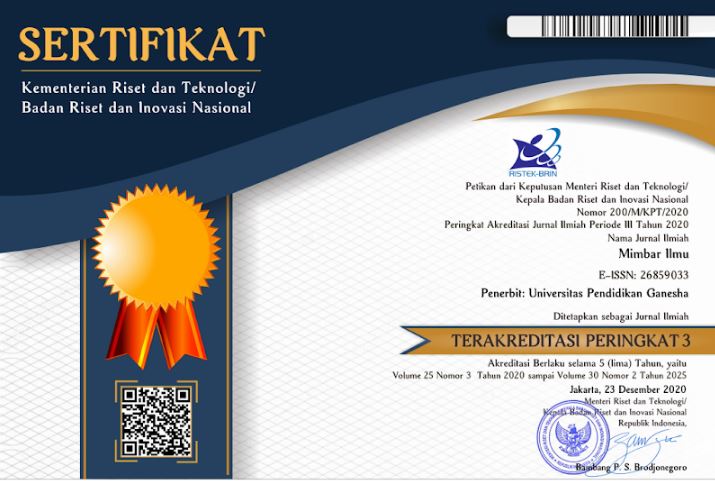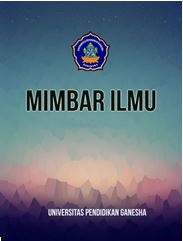Proposed Human Resource Competency for Society 5.0
DOI:
https://doi.org/10.23887/mi.v29i1.71535Keywords:
Society 5.0, Competency Model, Human Resource, Human DevelopmentAbstract
Society 5.0 can also be interpreted as a concept of a human-centered and technology-based society. The competency model will support the effectiveness of the recruitment and selection process so that companies can attract the talents needed to build their HR performance. Thus, the development of a competency model for Society 5.0 has considerable value in terms of education, training, and human development perspectives in facing the era of change, especially Society 5.0. The purpose of this study is to conduct an in-depth analysis of existing research and practice competency models and continue the development of competency models for Society 5.0. The research method uses Systematic Literature Review (SLR) is a research method used to collect, review and synthesize relevant literature in a particular research field. A literature search was conducted through academic databases, such as PubMed, ERIC, and Google Scholar, using appropriate keywords such as “human resource competency”, “society 5.0”. Next, this data is analyzed to identify patterns, trends, and consistencies in the findings. This study found that concepts of industrial revolution 4.0 and Society 5.0 focus on increasing the digitalization of the value chain, with humans as the main component in Society 5.0. To face the Society 5.0 era, human resources need to adapt to future challenges with high-level thinking abilities. Society 5.0 presents opportunities and challenges for companies. Human resource competency requires hard skills that are adapted to the Society 5.0 era.
References
Agustini, K., Santyasa, I. W., & Ratminingsih, N. M. (2019). Analysis of competence on “TPACK”: 21st century teacher professional development. Journal of Physics: Conference Series, 1387(012035), 1–9. https://doi.org/10.1088/1742-6596/1387/1/012035.
Ahmed, M., Guo, Q., Qureshi, M. A., Raza, S. A., Khan, K. A., & Salam, J. (2021). Do green HR practices enhance green motivation and proactive environmental management maturity in hotel industry? International Journal of Hospitality Management, 94, 102852. https://doi.org/10.1016/j.ijhm.2020.102852.
Aini, Q., Rahardja, U., Tangkaw, M. R., Santoso, N. P. L., & Khoirunisa, A. (2020). Embedding a Blockchain Technology Pattern Into the QR Code for an Authentication Certificate. Jurnal Online Informatika, 5(2), 239. https://doi.org/10.15575/join.v5i2.583.
Ali, M. (2021). Vocational students’ perception and readiness in facing globalization, industry revolution 4.0 and society 5.0. Journal of Physics: Conference Series, 1833(1), 0–7. https://doi.org/10.1088/1742-6596/1833/1/012050.
Almaududi, S. (2018). Employee Performance: a Perspective of Organizational Citizenship Behavior (Ocb). Journal of Business Studies and Management Review (JBSMR), 2(1), 35–38. https://doi.org/10.22437/jbsmr.v2i1.6459.
Andriana, E., Fauzany, P. S. D., & Alamsyah, T. P. (2022). 21st Century Multimedia Innovation: Development of E-LKPD Based On Scientific Inquiry in Science Class. Journal of Innovation in Educational and Cultural Research, 3(4), 731–736. https://doi.org/10.46843/jiecr.v3i4.242.
Asignacion, A. P., Gutlay, O. L., Menorca, E. L., & Orleans, A. V. (2021). Influence of Metacognitive Self-Regulation Learning (SLR) Strategies and Regulation of Cognition (ROC) on Student’s Ability to Solve Math Problems. IOER International Multidisciplinary Research Journal, 3(3), 81–86. https://www.ioer-imrj.com/wp-content/uploads/2021/09/Influence-of-Metacognitive-Self.
Astuti, A. P., Aziz, A., Sumarti, S. S., & Bharati, D. A. L. (2019). Preparing 21st Century Teachers: Implementation of 4C Character’s Pre-Service Teacher through Teaching Practice. Journal of Physics: Conference Series, 1233(1). https://doi.org/10.1088/1742-6596/1233/1/012109.
Avando Bastari, Adi Bandono, & Okol Sri Suharyo. (2021). The development strategy of smart campus for improving excellent navy human resources. Global Journal of Engineering and Technology Advances, 6(2), 033–043. https://doi.org/10.30574/gjeta.2021.6.2.0011.
Birsyada, M. I., Gularso, D., & Fairuzabadi, M. (2022). Learning Development Strategy for the History of the Japanese Occupation in Indonesia Based on Museum Dioramas in Schools. Diakronika, 22(1), 76–93. https://doi.org/10.24036/diakronika/vol22-iss1/272.
Boyatzis, R., & Boyatzis, R. E. (2008). Competencies in the 21st century. Journal of Management Development, 27(1), 5–12. https://doi.org/10.1108/02621710810840730.
Bravo, M. C. M., Chalezquer, C. S., & Serrano-Puche, J. (2021). Meta-framework of digital literacy: Comparative analysis of 21st century skills frameworks. Revista Latina de Comunicacion Social, 2021(79), 76–110. https://doi.org/10.4185/RLCS-2021-1508.
Budiarti, E. M., Gunawan, I., & Pambudi, B. A. (2020). The Effect of Spiritual Leadership and Academic Supervision on Teacher Performance. 501(Icet), 157–161. https://doi.org/10.2991/assehr.k.201204.027.
Carayannis, E. G., & Morawska-Jancelewicz, J. (2022). The Futures of Europe: Society 5.0 and Industry 5.0 as Driving Forces of Future Universities. Journal of the Knowledge Economy, 0123456789. https://doi.org/10.1007/s13132-021-00854-2.
Cerika, A., & Maksumic, S. (2017). The Effects of New Emerging Technologies on Human Resources: ! Emergence of Industry 4.0, a Necessary Evil?! 1–93.
Cohen, D. J. (2015). HR past, present and future: A call for consistent practices and a focus on competencies. Human Resource Management Review, 25(2), 205–215. https://doi.org/10.1016/j.hrmr.2015.01.006.
Davies, A., Fidler, D., & Gorbis, M. (2011). Future work skills 2020. University of Phoenix Research Institute, 19.
Deguchi, A., Hirai, C., Matsuoka, H., Nakano, T., Oshima, K., Tai, M., & Tani, S. (2018). Society 5.0 A People-centric Super-smart Society. Springer open.
Elas, N. I. B., Majid, F. B. A., & Narasuman, S. Al. (2019). Development of Technological Pedagogical Content Knowledge (TPACK) for English teachers: The validity and reliability. International Journal of Emerging Technologies in Learning, 14(20), 18–33. https://doi.org/10.3991/ijet.v14i20.11456.
Ellitan, L. (2020). Competing in the era of industrial revolution 4.0 and society 5.0. Jurnal Maksipreneur: Manajemen, Koperasi, Dan Entrepreneurship, 10(1), 1–12. https://doi.org/10.30588/jmp.v10i1.657.
Fırat, E. E., & Laramee, R. S. (2018). Towards a survey of interactive visualization for education. Computer Graphics and Visual Computing, CGVC 2018, 91–101. https://doi.org/10.2312/cgvc.20181211.
Gandasari, D., Dwidienawati, D., & Sarwoprasodjo, S. (2020). Discourse analysis: The impact of industrial revolution 4.0 and society 5.0 in Indonesia. International Journal of Advanced Science and Technology, 29(3), 5189–5199. https://doi.org/10.30880/ijast.2020.10.01.009.
Gardner, T. A. (2017). Exploring the Importance of Soft Skills Training for Accountants. Walden University.
Gauthier, T. (2020). The value of microcredentials: The employer’s perspective. The Journal of Competency‐Based Education, 5(2), 1–6. https://doi.org/10.1002/cbe2.1209.
Gede, B. L. L., & Ketut, Y. (2018). The Effect of Intelligence Quotient on the Level of Understanding of Accounting with Spiritual Quotient and Adversity Quotient as a Moderating Variables. International Journal of Sciences: Basic and Applied Research, 41(1), 148–157. https://core.ac.uk/download/pdf/249336453.pdf.
Gladden, M. E. (2019). Who Will Be The Members Of Society 5.0? Towards An Anthropology Of Technologically Posthumanized Future Societies. Social Sciences, 8(5), 148. https://doi.org/10.3390/socsci8050148.
Hartati, S., Nurdin, D., & Herawan, E. (2022). Digital Leadership in Higher Education Facing the Challenges Towards Society 5.0. Proceeding of International Conference on Research of Educational Administration and Management (ICREAM), 6(1), 85–87. http://proceedings.upi.edu/index.php/ICREAM/article/view/2745.
Hecklau, F., Galeitzke, M., Flachs, S., & Kohl, H. (2016). Holistic Approach for Human Resource Management in Industry 4.0. Procedia CIRP, 54(December), 1–6. https://doi.org/10.1016/j.procir.2016.05.102.
Hermawan, I., Supiana, S., & Zakiah, Q. Y. (2020). Kebijakan Pengembangan Guru di Era Society 5.0. JIEMAN: Journal of Islamic Educational Management, 2(2), 117–136. https://doi.org/10.35719/jieman.v2i2.33.
Ituma, A. (2011). An evaluation of students’ perceptions and engagement with e-learning components in a campus-based university. Active Learning in Higher Education, 12(1), 57–6. https://doi.org/10.1177/1469787410387722.
Jaakkola, M., Sternö, L., & Fryk, E. (2022). Domesticating space: Media production pedagogy for the empowerment of marginalized youth. Journal of Media Literacy Education, 14(3), 17–28. https://doi.org/10.23860/JMLE-2022-14-3-2.
Kaliannan, M., & Chandran, S. D. (2010). Education in human values (EHV): Alternative approach for a holistic teaching. Educational Research and Reviews, 5(12), 802–807. https://www.academia.edu/download/83823072.
Kanokorn, S., Wallapha, A., & Ngang, T. K. (2013). Indicators of Ethical Leadership for School Principals in Thailand. Procedia - Social and Behavioral Sciences, 93, 2085–2089. https://doi.org/10.1016/j.sbspro.2013.10.170.
Kin, T. M., Abdull Kareem, O., Nordin, M. S., & Wai Bing, K. (2018). Principal change leadership competencies and teacher attitudes toward change: the mediating effects of teacher change beliefs. International Journal of Leadership in Education, 21(4), 427–446. https://doi.org/10.1080/13603124.2016.1272719.
Kivunja, C. (2015). Unpacking the Information, Media, and Technology Skills Domain of the New Learning Paradigm. International Journal of Higher Education, 4(1), 3–6. https://doi.org/10.5430/ijhe.v4n1p166.
Kolesnikov, A., Zhai, X., & Beyer, L. (2019). Revisiting self-supervised visual representation learning. Proceedings of the IEEE Computer Society Conference on Computer Vision and Pattern Recognition, 2019-June, 1920–1929. https://doi.org/10.1109/CVPR.2019.00202.
Liu, Z. J., Tretyakova, N., Fedorov, V., & Kharakhordina, M. (2020). Digital Literacy and Digital Didactics As The Basis for New Learning Models Development. International Journal of Emerging Technologies in Learning, 15(14), 4–18. https://doi.org/10.3991/ijet.v15i14.14669.
Mahoney, B. B., Oostdam, R. R., Nieuwelink, H. H., & Schuitema, J. J. (2023). Learning to think critically through Socratic dialogue: Evaluating a series of lessons designed for secondary vocational education. Thinking Skills and Creativity, 50. https://doi.org/10.1016/j.tsc.2023.101422.
Mami, S., & Arayesh, B. (2010). Comparative study of educational status and behavioral disorder between slow-learner and normal students of Ilam province (2007-2008). Procedia - Social and Behavioral Sciences, 5, 221–225. https://doi.org/10.1016/j.sbspro.2010.07.076.
Manfra, M. M. (2019). Action research and systematic, intentional change in teaching practice. Review of Research in Education, 43(1), 163–196. https://doi.org/10.3102 /0091732X18821132.
Mccartney, S., Murphy, C., & Mccarthy, J. (2020). 21st century HR : a competency model for the emerging role of HR Analysts model. https://doi.org/10.1108/PR-12-2019-0670.
Nguyen, T. H. (2016). Building Human Resources Management Capacity for University Research: The Case at Four Leading Vietnamese Universities. Higher Education, 71(2), 231–251. https://doi.org/10.1007/s10734-015-9898-2.
Parvathamma, N., & Pattar, D. (2013). Digital literacy among student community in management institutes in Davanagere District, Karnataka State, India. Annals of Library and Information Studies (ALIS), 60(3), 159–166. https://doi.org/10.56042/alis.v60i3.863.
Petrillo, A., Felice, F. De, Cioffi, R., & Zomparelli, F. (2018). Fourth Industrial Revolution: Current Practices, Challenges, and Opportunities. Digital Transformation in Smart Manufacturing, 1–20. https://doi.org/10.5772/intechopen.72304.
Rosmadi, M. L. N., Herlina, H., K, E. W., & Tachyan, Z. (2019). The Role of Indonesian Human Resources in Developing MSMEs Facing the Industrial Revolution 4.0. Budapest International Research and Critics Institute (BIRCI-Journal) : Humanities and Social Sciences, 2(1). https://doi.org/10.33258/birci.v2i1.165.
Sang, Y., Tan, J., & Liu, W. (2021). A new many-objective green dynamic scheduling disruption management approach for machining workshop based on green manufacturing. Journal of Cleaner Production, 297, 126489. https://doi.org/10.1016/j.jclepro.2021.126489.
Sitohang, H., Mohamed, Z., & Ismail, S. (2022). Achieving the Use of National Employment Work Competency Standards for Training Workers in the Construction Sector in Indonesia. Budapest International Research and Critics Institute-Journal (BIRCI-Journal), 5(1), 5165–5178. https://doi.org/10.33258/birci.v5i1.4216.
Skobelev, P. O., & Borovik, S. Y. (2017). On The Way from Industry 4.0 To Industry 5.0: From Digital Manufacturing To Digital Society. On The Way from Industry 4.0 To Industry 5.0: From Digital Manufacturing To Digital Society, 2(6), 307–311. https://stumejournals.com/journals/i4/2017/6/307.
Suryadi, S., Kushardiyanti, D., & Gusmanti, R. (2021). Challenges of Community Empowerment in the Era of Industry Society 5.O. KOLOKIUM Jurnal Pendidikan Luar Sekolah, 9(2), 160–176. https://doi.org/10.24036/kolokium-pls.v9i2.492.
Teitel, S., & Teitel, S. (2000). Manufacturing Industry. Technology and Skills in Zimbabwe’s Manufacturing, 18–25. https://doi.org/10.1057/9780230514027_2.
Tri, N. M., Hoang, P. D., & Dung, N. T. (2021). Impact Of The Industrial Revolution 4.0 On Higher Education In Vietnam: Challenges And Opportunities. Linguistics And Culture Review, 5(S3), 1–15. https://doi.org/10.21744/Lingcure.V5ns3.1350.
Tripathi, K., & Agrawal, M. (2014). Competency Based Management In Organizational Context : A Literature Review. Global Journal of Finance and Management., 6(4), 349–356. http://www.ripublication.com/gjfm-spl/gjfmv6n4_10.pdf.
Tsai, C. W. (2020). Applying online competency-based learning and design-based learning to enhance the development of students’ skills in using PowerPoint and Word, self-directed learning readiness, and experience of online learning. Universal Access in the Information Society, 19(2), 283–294. https://doi.org/10.1007/s10209-018-0640-6.
Ulyawati, & Sugito. (2022). Digitization of Elementary School Science Learning In The Industrial Era 4.0. Al-Ishlah: Jurnal Pendidikan, 14(2), 2049–2064. https://doi.org/10.35445/alishlah.v14i1.746.
Uygun, Y. (2018). Human Resources Requirements for Industry 4 . 0. Journal of Open Innovation: Technology, Market, and Complexity, 1–20. https://www.sciencedirect.com/science/article/pii/S0148296322002995.
Vartiainen, H., Pöllänen, S., & Liljeström, A. (2016). Designing Connected Learning: Emerging learning systems in a craft teacher education course. Design And, 21(2), 32–40. https://ojs.lboro.ac.uk/DATE/article/download/2115/2281.
Wagiran, Pardjono, Suyanto, W., Sofyan, H., Soenarto, S., & Yudantoko, A. (2019). Competencies of future vocational teachers: Perspective of in-service teachers and educational experts [Kompetensi guru kejuruan masa depan: Perspektif guru dan ahli pendidikan]. Cakrawala Pendidikan, 38(2), 388–400. https://doi.org/10.21831/cp.v38i2.25393.
Wahjusaputri, S., Fitriani, S., Indah Nastiti, T., & Syukron, A. (2020). Teaching Factory Model for Increasing the Competency of Vocational Secondary Education Students in Indonesian Territory. International Journal of Innovation, Creativity and Change, 11(1). https://eric.ed.gov/?id=EJ1340976.
Yildirim, S. (2017). Approaches of Designers in the Developed Educational Purposes of Infographics ’ Design Processes. European Journal of Education Studies, 3(1), 248–284. https://doi.org/10.5281/zenodo.231283.
Yuliana, N., Purwati, N., & Hanapi, H. (2022). Improving student’s logical thinking abilities and learning outcomes through guided inquiry model. Prisma Sains: Jurnal Pengkajian Ilmu Dan Pembelajaran Matematika Dan IPA IKIP Mataram, 10(2), 345–351. https://doi.org/10.33394/j-ps.v10i2.4822.
Downloads
Published
How to Cite
Issue
Section
License
Copyright (c) 2023 Anggia Sari Lubis, Abdul Rahman Lubis

This work is licensed under a Creative Commons Attribution-ShareAlike 4.0 International License.
This work is licensed under a Creative Commons Attribution-ShareAlike 4.0 International License.
Authors who publish with this journal agree to the following terms:
- Authors retain copyright and grant the journal right of first publication with the work simultaneously licensed under a Creative Commons Attribution License that allows others to share the work with an acknowledgment of the work's authorship and initial publication in this journal.
- Authors are able to enter into separate, additional contractual arrangements for the non-exclusive distribution of the journal's published version of the work (e.g., post it to an institutional repository or publish it in a book), with an acknowledgment of its initial publication in this journal.
- Authors are permitted and encouraged to post their work online (e.g., in institutional repositories or on their website) prior to and during the submission process, as it can lead to productive exchanges, as well as earlier and greater citation of published work.









